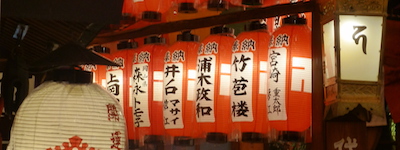As mentioned in previous posts, I have been reading Murakami’s 1Q84 in Japanese (very slowly). I read the English translation when it was first published but I had never looked up any reviews. The Japanese paperback comes in six volumes and after finishing the third volume*, I decided to check some reviews, and I was somewhat surprised to find that most critics didn’t like the book very much.
One of the recurrent criticisms is that the characters repeat one another frequently. This is in particular the case for the conversations between Tengo and Fuka-eri.
Murakami mentions that Fuka-eri has dyslexia and based on her behaviour and speech it is likely that she also has autistic spectrum disorder (Murakami describes her speech as monotonous or flat, and she clearly prefers to use single words, although she can speak in full sentences; her facial expression is impossible to read; there are many more hints like this).
In Japanese, Murakami uses a specific writing style to express Fuka-eri’s way of speaking. Japanese has three sets of characters: hiragana and katakana which are phonetic alphabets, and Chinese characters (kanji). In general, kanji are used to indicate the meaning of words, hiragana is used to express the grammar and katakana is used for foreign words or as a kind of italics. Japanese has few distinct sounds, there are lots of homonyms, and the kanji disambiguate the meanings for the homonyms. However, katakana and hiragana can be used to phonetically write kanji but sentences without kanji can be difficult to read, especially because no spaces are used between words. Murakami renders Fuka-eri’s speech using hiragana and katakana characters only, without kanji. For example:
「セキブンのはなしはおもしろかった」
「予備校の僕の講義のこと?」
ふかえりは肯いた。
「君は数学は好き?」
ふかえりは短く首を振った。数学は好ではない。
「でも積分の話は面白かったんだ?」と天語は尋ねた。
In the English translation by Jay Rubin, the exchange is:
‘The calculus part was good.’
‘You mean in my lecture?’
Fuka-eri nodded.
‘Do you like math?’
She gave her head a quick shake. She did not like math.
‘But the part about calculus was good? he asked.’
Even though the translator has changed the wording slightly, the last sentence still mostly repeats the first.
When written in roman alphabet, the first and the last sentence of the Japanese dialogue are virtually identical:
‘sekibun no hanashi wa omoshirokatta’
‘demo sekibun no hanashi wa omoshirokatta?’
However, although the pronunciation is word for word identical, the effect in the original Japanese text is different because the first sentence, said by Fuka-eri, is written only in hiragana and katakana characters, while the last sentence, said by Tengo, uses kanji. For example, while sekibun has only one meaning, the seki in sekibun could mean amongst others “stone” or “seat” or “red”; bun could mean amongst others ”minute”, “sentence” or “mosquito”. Without the kanji it is harder for the reader, and requires more context, to work out the meaning.
Furthermore, Japanese has the particular grammar feature of particles (joshi, 助詞). These are suffixes or short words that immediately follow a noun, verb, adjective, or sentence and can act as conjunctions, prepostions or modifiers. Some of these particles are attached at the very end of the sentence to add an emotion or tone, or convey that the sentence is a question. Fuka-eri never uses those sentence-ending particles, and in particular the question marking particle. As her speech is uninflected, and the word order in Japanese is the same for statements and questions, it is not always clear if she is asking a question or just stating something. For example:
「わたしをだきたくない」とふかえりは疑問符抜きで尋ねた。
‘watashi wo dakitakunai’ to fukaeri wa gimonfunuki de tazuneta.
Which Jay Rubin translates as:
‘You don’t want to hold me,’ Fuka-eri asked without a question mark.
Because of the lack of question mark or particle, there is no way to know if this is a question or not.
A proper Japanese sentence would have been either「私を抱きたくないか」or 「私を抱きたくない?」and indeed, Tengo says:
「君を抱く?」
‘Hold you?’
The lack of kanji and particles means that Fuka-eri’s sentences in Japanese are often quite ambiguous. So when Tengo repeats Fuka-eri’s sentences, he’s making sure that he understands her correctly, but Murakami also uses this to clarify to the reader what she’s just said. For example,
「イヘンがあろうとしている」
「イヘン」と天吾は言った。それが「異変」であると思い当たるまでに少し時間がかかった。
‘ihen ga arou toshite iru’
‘ihen’ to tengo wa itta. sore ga ‘ihen’ de aru to omoiataru made ni sukoshi jikan ga kakatta.
The meaning of “ihen” (イヘン) is not clear when written in katakana. In fact, a possible meaning of the sentence could be ‘You’ll have a leather cord’. The Japanese sentence actually says that it takes a while for Tengo to realise that “ihen”,イヘン means ”something unusual”,異変. In the English translation, this becomes
‘That something extra ordinary is starting.’
It took Tengo a moment to realize this meant “extraordinary”.
Jay Rubin has left out the sentence ‘ihen’ to tengo wa itta. He could have translated it as ‘Extra ordinary’ said Tengo, but that would have made the exchange even more repetitive.
In the Japanese version of 1Q84, the exchanges with Fuka-eri are my favourite parts. Her sentences are very easy to read, except for the lack of kanji; then Tengo’s paraphrasing puts in the kanji as well. So as a learner I get both the reading and the meaning. Another example:
「わたしはここにのこっている」とふかえりは言った。
「君はここに残っている」と天語は反復した。
‘watashi wa koko ni nokotte iru’ to fukaeri wa itta.
‘kimi wa koko ni nokotte iru’ to tengo wa hanpuku shita.
The translation says:
‘I’ll stay here,’ Fuka-eri said.
‘You’ll stay here,’ Tengo echoed her.
Again, this looks more repetitive than the original.
The English translation of the first two books is by Jay Rubin, who is very renowned for translating Murakami’s works, and I think his translation of 1Q84 is excellent. However, the repetition in the English translation is fundamentally different from the Japanese original because of the writing system. It is impossible to translate the effect of the difference between words writtin in hiragana, katakana and kanji into a language with a single alphabet-based writing system like English.
*After four years of reading.
